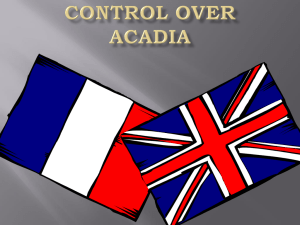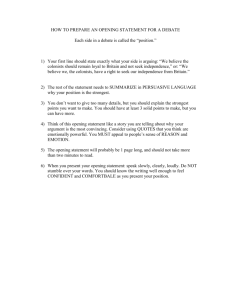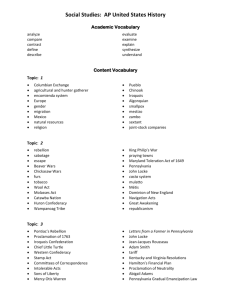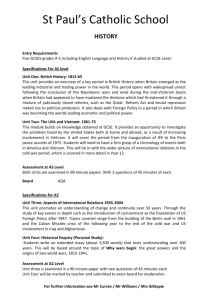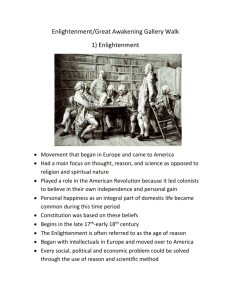1301.TopicFive.doc
advertisement
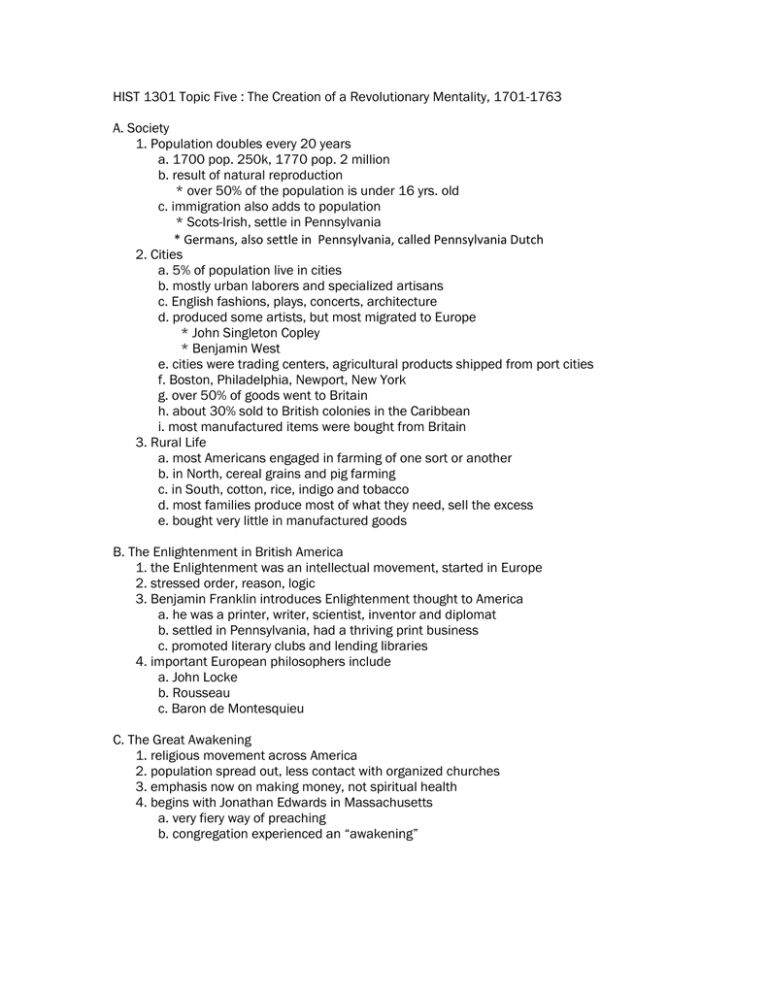
HIST 1301 Topic Five : The Creation of a Revolutionary Mentality, 1701-1763 A. Society 1. Population doubles every 20 years a. 1700 pop. 250k, 1770 pop. 2 million b. result of natural reproduction * over 50% of the population is under 16 yrs. old c. immigration also adds to population * Scots-Irish, settle in Pennsylvania * Germans, also settle in Pennsylvania, called Pennsylvania Dutch 2. Cities a. 5% of population live in cities b. mostly urban laborers and specialized artisans c. English fashions, plays, concerts, architecture d. produced some artists, but most migrated to Europe * John Singleton Copley * Benjamin West e. cities were trading centers, agricultural products shipped from port cities f. Boston, Philadelphia, Newport, New York g. over 50% of goods went to Britain h. about 30% sold to British colonies in the Caribbean i. most manufactured items were bought from Britain 3. Rural Life a. most Americans engaged in farming of one sort or another b. in North, cereal grains and pig farming c. in South, cotton, rice, indigo and tobacco d. most families produce most of what they need, sell the excess e. bought very little in manufactured goods B. The Enlightenment in British America 1. the Enlightenment was an intellectual movement, started in Europe 2. stressed order, reason, logic 3. Benjamin Franklin introduces Enlightenment thought to America a. he was a printer, writer, scientist, inventor and diplomat b. settled in Pennsylvania, had a thriving print business c. promoted literary clubs and lending libraries 4. important European philosophers include a. John Locke b. Rousseau c. Baron de Montesquieu C. The Great Awakening 1. religious movement across America 2. population spread out, less contact with organized churches 3. emphasis now on making money, not spiritual health 4. begins with Jonathan Edwards in Massachusetts a. very fiery way of preaching b. congregation experienced an “awakening” 5. this new religious phenomena spreads a. emphasize a spiritual rebirth b. must be emotional, dramatic, and public c. itinerant preachers carry the message to rural populations d. followers were known as “new lights” 6. importance of the Great Awakening a. religious toleration b. two Protestant churches become popular, Baptists and Methodists c. universities founded to teach Great Awakening principles * Princeton, Dartmouth, Brown and Rutgers d. showed a willingness to challenge traditional authority D. Colonial Wars 1. Between 1688-1763, Europe engages in a series of wars a. goal is economic domination in a mercantile economy b. these are the first of the “world wars” c. these wars will also spill over to North/South America d. brings the British colonists into competition with the French Canadiens e. guerilla warfare, not trained armies f. also involved native allies of the French and English 2. King William’s War 1689-1697 (War of the Grand Alliance) a. involved conflict between British/French in New England/New York b. Treaty of Ryswick ends the war, back to status quo ante-bellum 3. Queen Anne’s War 1702-1713 (War of the Spanish Succession) a. fought from South Carolina to New England b. ended by the Treaty of Utrecht * British gain L’Acadie Province, which they rename Nova Scotia * also gain Newfoundland Island and control over Hudson Bay (Canada) 4. House of Hanover replaces the House of Stuart in Britain a. the death of Queen Anne placed her distant German cousin on the throne b. George, Prince of Hanover, was a great-grandson of James I c. moved his whole family to London, direct descendents rule today 5. Continued friction between the British Americans and French Canadiens a. although Britain and France at peace, colonists still conducted raids b. British Americans have their eyes on the Mississippi River Valley c. French construct defensive forts along Mississippi River tributaries 6. British Americans also have trouble with the Spanish in Florida a. France/Spain were allies b. Georgia founded as a buffer between S. Carolina and Florida c. War of Jenkins’ Ear 1739-1742, seques into the War of the Austrian Succession 7. King George’s War 1742-1748 (War of the Austrian Succession) a. June 1745 British Americans capture Fort Louisbourg b. important because it guarded access to Gulf of St. Lawrence (St. Lawrence River) c. Treaty of Aix-la-Chapelle returns Louisbourg to France d. angered the Americans e. in 1749, the French in Nova Scotia are deported, they migrated to Louisiana 8. Focus shifts to the Ohio River Valley a. French built defensive forts there too, Ft. Duquesne is the most important b. British Americans also try to build forts, but are unsuccessful 9. Albany Congress meets in 1754 a. very important stepping stone to unity b. colonists, British leaders, Natives all meet at Albany c. Ben Frankin presents the Albany Plan of Union * merge the colonies into one * was rejected, but the seed had been planted d. Iroquois given gifts to ensure the alliance 10. War of the Ohio Valley 1755 a. major defeat for the British and Americans b. will segue into the French and Indian War 11. The French and Indian War 1756-1763 (Seven Year’s War) a. last of the major European/American wars b. this time Britain sent an army to North America c. PM William Pitt believed that control over America would decide economic success d. Louisbourg captured in July 1758, opened the way to Quebec e. Quebec captured September 1759 (see The Death of Wolfe by Benjamin West) f. Battle of Montreal, September 1760, French surrender g. Treaty of Paris, 1763 officially ended the war h. British Empire created, “empire on which the sun never sets” 12. Results of the French and Indian War a. British resentment against the colonists b. American resentment against the British c. American soldiers acquired military experience d. disastrous for the Natives e. shift in British economic policy f. biggest threat to American growth, the French, now removed g. Americans were now free to assess their place in the new British Empire
